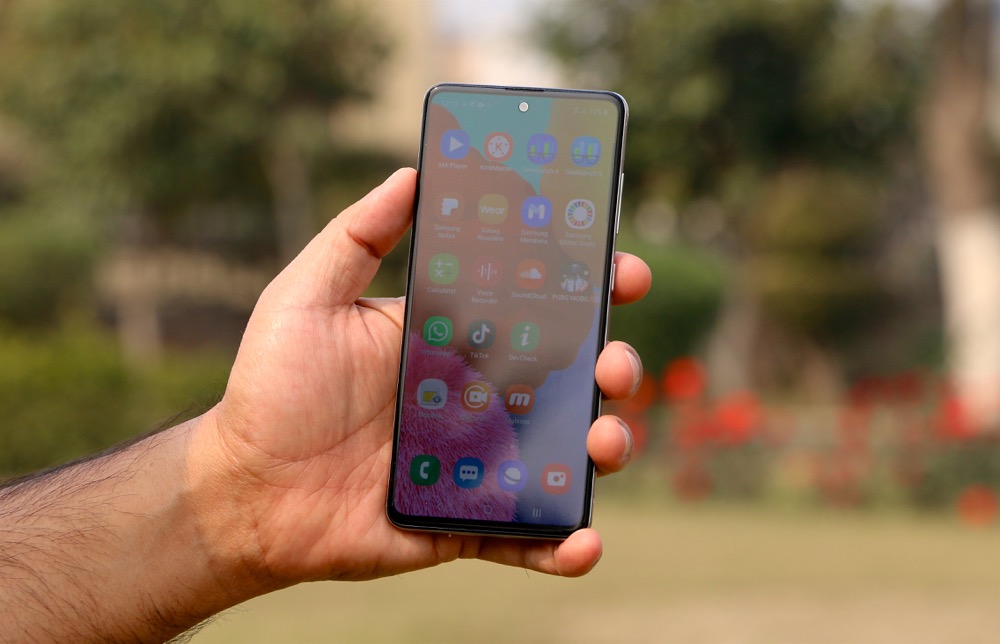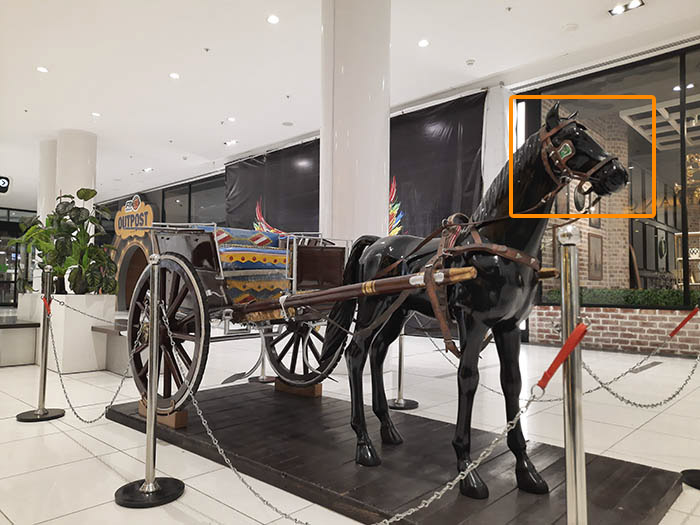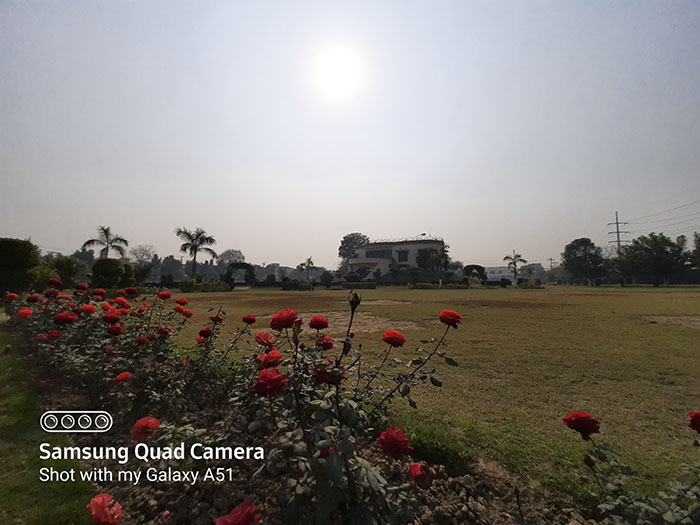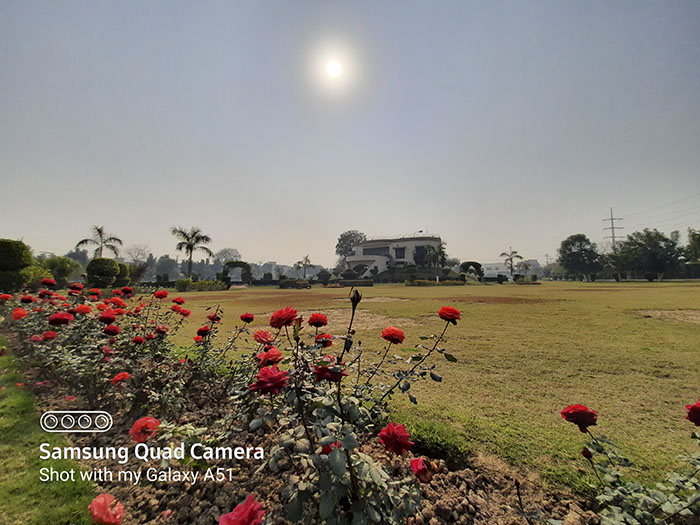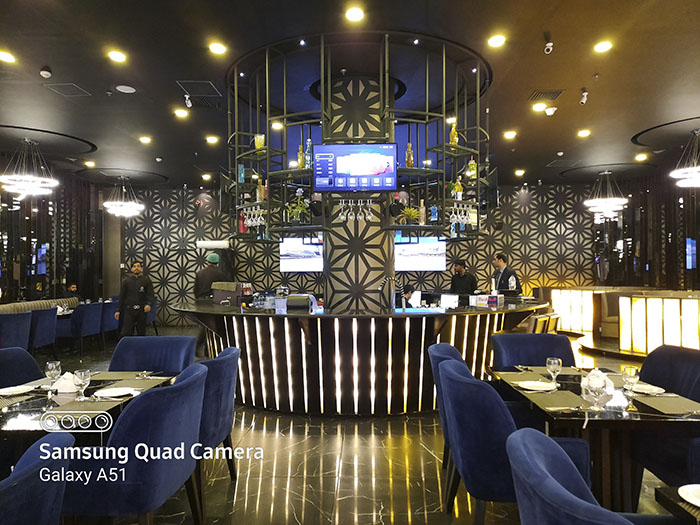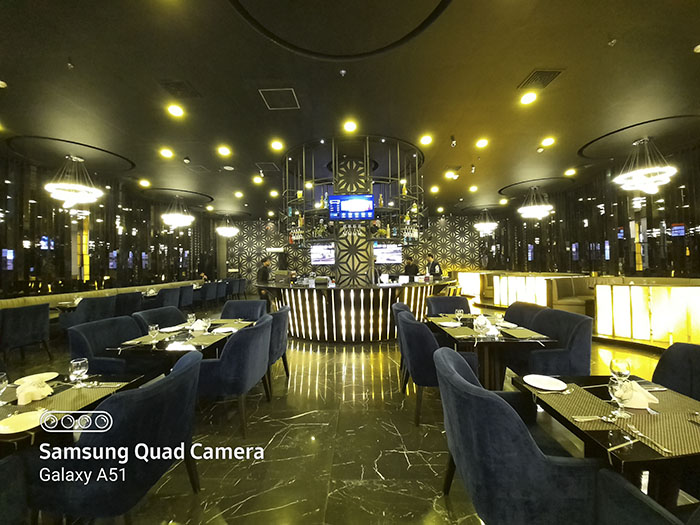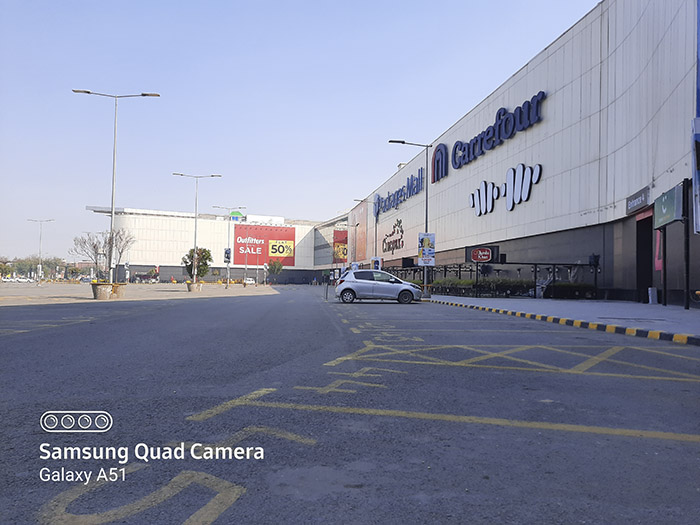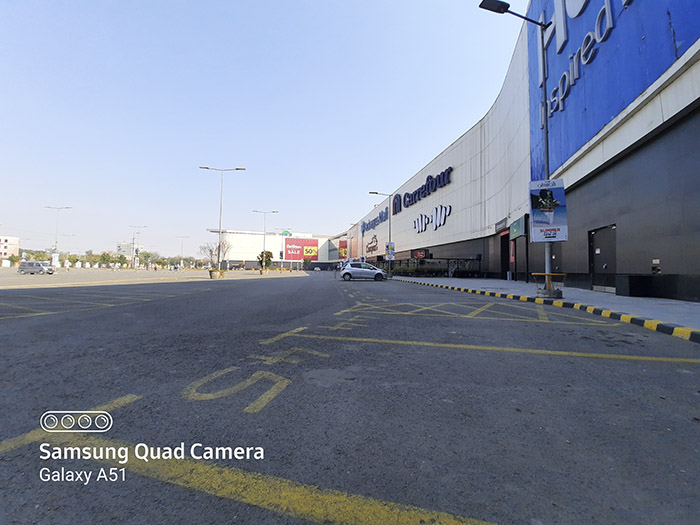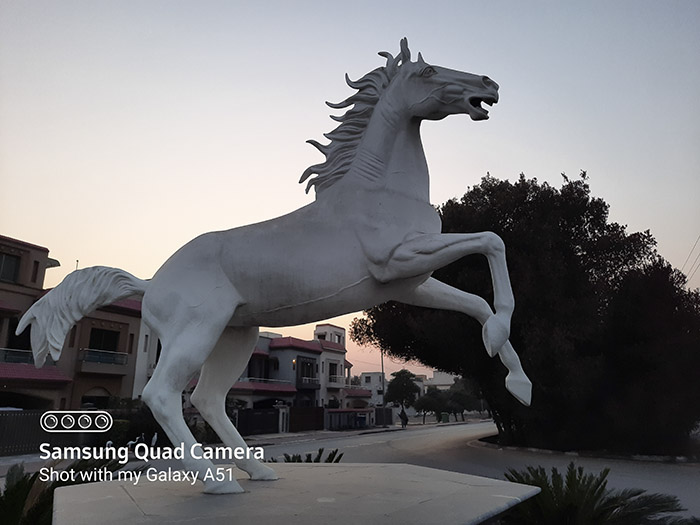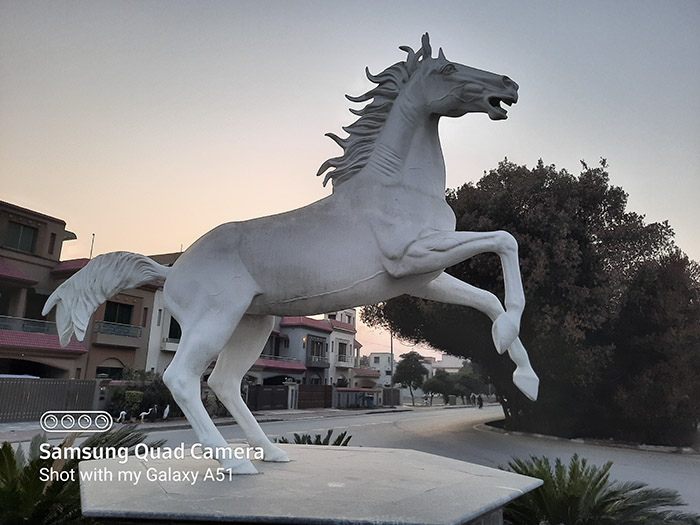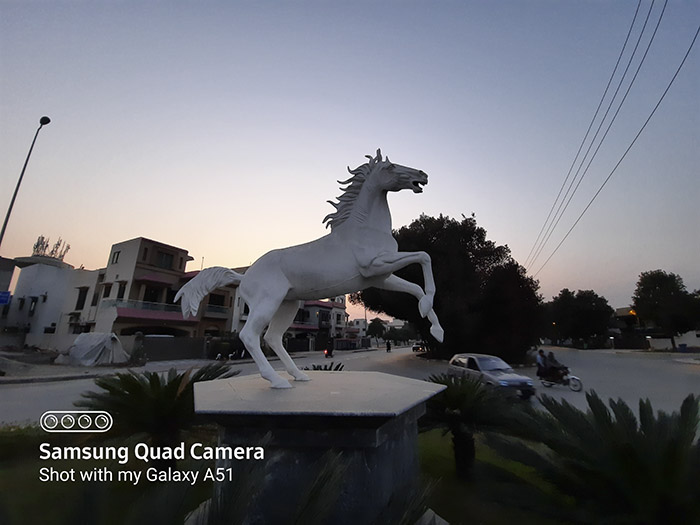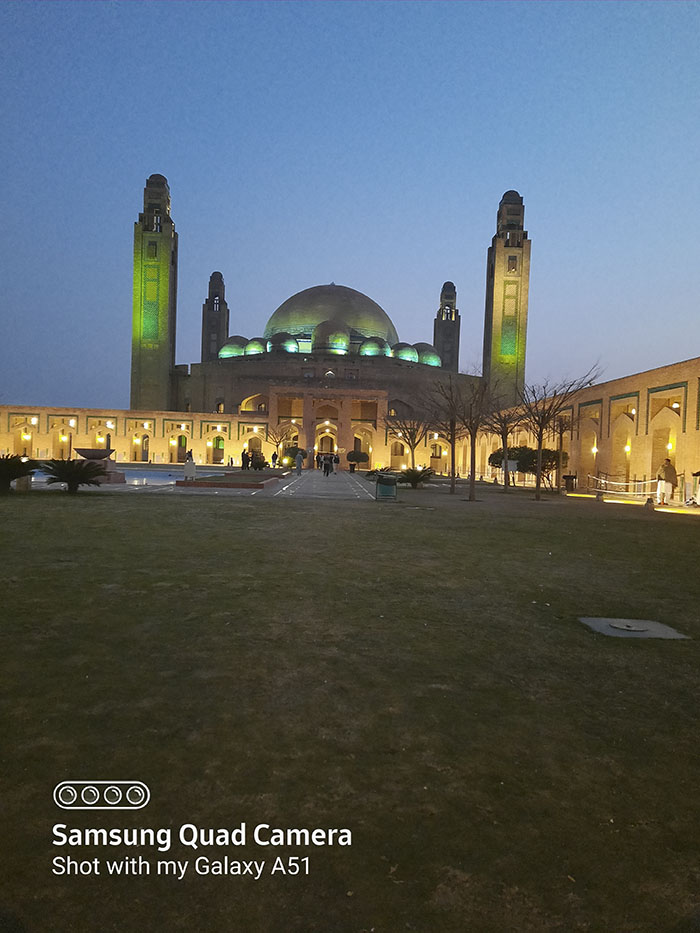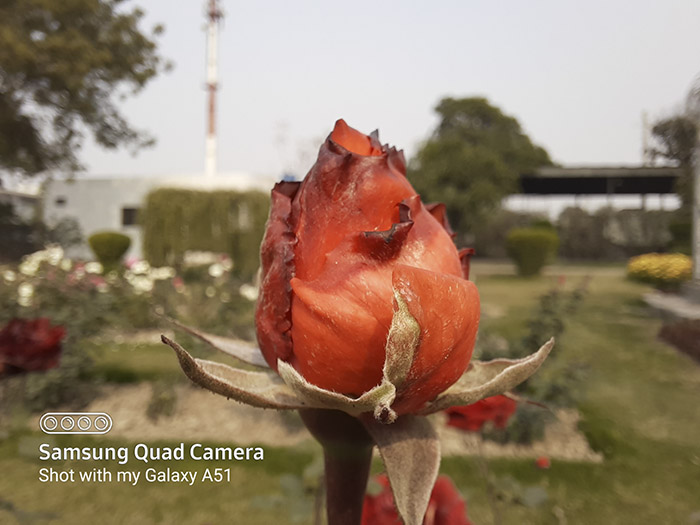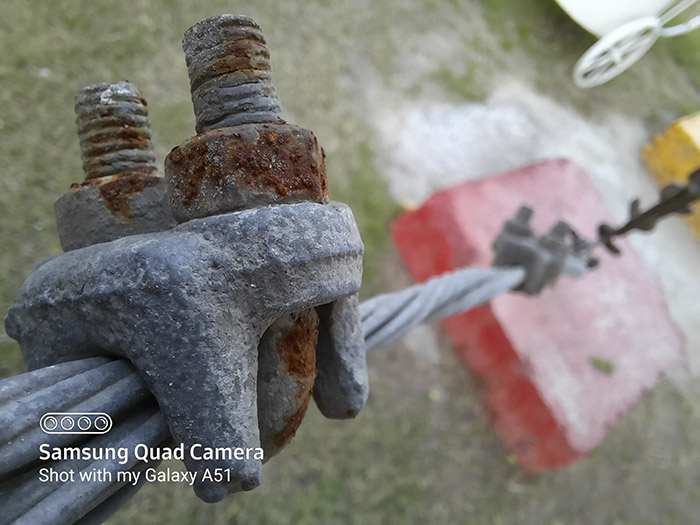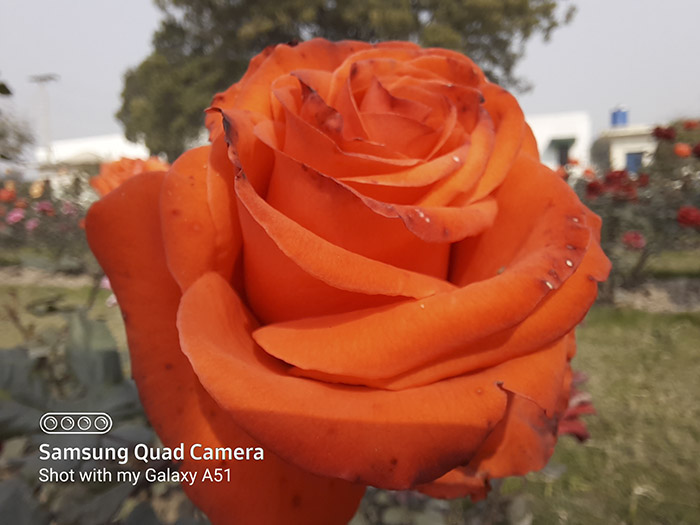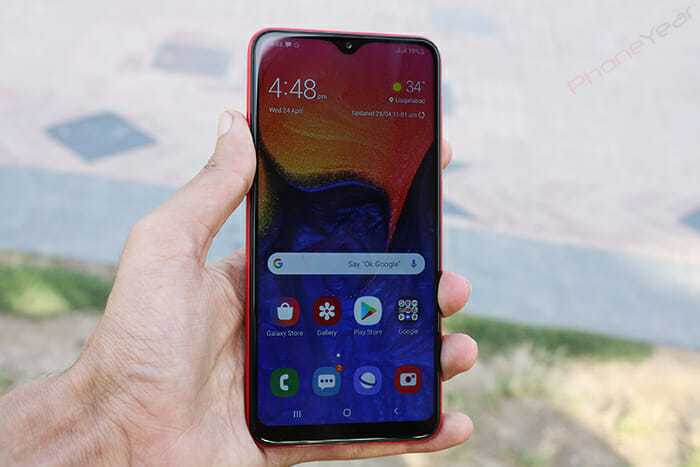Samsung Galaxy A51 and the rest of the A-series family, including the latest A71, seem part of the strategy to counter rivals at almost every price bracket. Last year, the predecessor A50 turned out to be a decent mid-range performer for the day to day usage, though, same can’t be true for an aggressive mobile user. The 2020 model has stepped up the specs sheet in most of the departments, primary being the quad-camera setup, Android 10, and One UI 2.0.
Can this upgraded chipset deliver what was missing in the earlier version? Does this device has what it takes to be one of the best mid-range phones of 2020? Let’s jump straight to our findings of the Galaxy A51.
Samsung Galaxy A51 specs
- Display: 6.47 inches, Super AMOLED
- OS: Android 10, One UI 2.0
- Chipset: Exynos 9611, GPU: Mali G72
- RAM/ROM: 6GB/128GB up to 512GB
- Camera (rear): 48MP + 12MP + 5MP + 5MP
- Camera (front): 32MP
- Battery: 4000 mAh
Design and Display
Samsung Galaxy A51 is visibly different than the predecessor. Unlike the A50 that relied on the Infinity-U display, the latest version features Infinity-O display, a punch hole locked at the top middle of the screen and which is also the reason we are witnessing a little more truncated top bezel and the full view display. However, not significant, all four bezels are not as slim as we see on Samsung’s flagship devices.
At 172gm, it is marginally heavier than 166gm of A50; it still feels lighter on hands considering the fact there is a 4000 mAh battery inside. The 3.5mm headphone jack, USB Type-C, and a single firing speaker grille are locked at the bottom area, whereas the volume keys and power button are placed on the right side. The latter one also doubles to activate Bixby with press+hold for a while when the display is active.
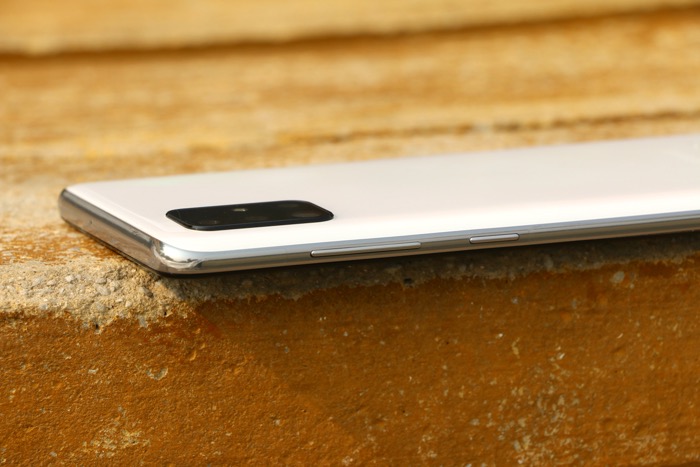
A51 offers a SIM tray on the left that can accommodate two nano-SIMs and a microSD card simultaneously.
Flip the phone to find a rhythmical pattern on a plastic body that is glossy and appears to belong to a premium phone family, but it’s a mid-range phone in reality. This prism-shaped design that refracts rainbow colors when light falls on it is so subtle that it augments the presence of an L-shaped quad-camera setup that juts out a millimeter from the body and does not cause any wobbling effect when placed flat on a surface.
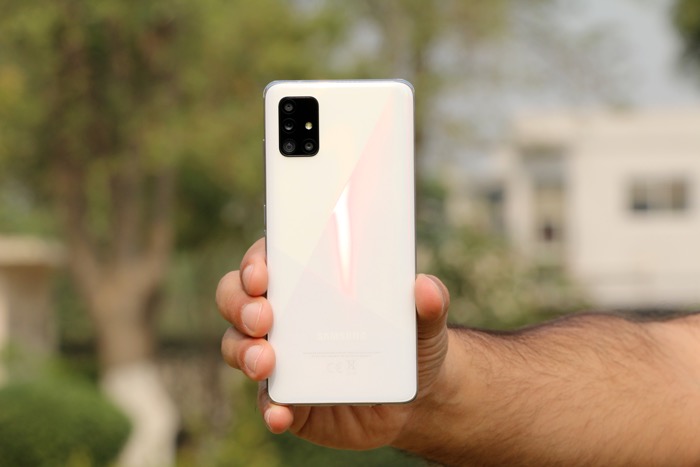
We used the phone in white color, which looks tempting, but the pink and black colors are not lesser beautiful either. There is protective silicon back cover that comes out of the box that we would recommend to paste on the rear to keep the phone spick and span.
Samsung Galaxy A51 offers 6.5 inches of Super AMOLED Full HD+ screen of 1080 x 2400 px resolution and 405 dpi. We also see Samsung’s usual aspect ratio of 20:9 that makes it a little elongated device that we are quite used to. It’s a tad bigger than 6.4 inches of A50 screen that accommodated lesser screen resolution and aspect ratio.
It’s a flat-screen that gives no trouble looking at it, both indoor and outdoor. Even the harsh sunlight doesn’t block the display much, but you might feel it getting a little dull for movie content under the sun. The colors are sharp, and the display is bright, though, not as impressive as Samsung’s upper models, but its vividness can be further boosted up from the display settings (Setting>>Display>>Screen mode) where in addition to selecting ‘natural’ or ‘vivid’ option, you can also tweak RGB colors.
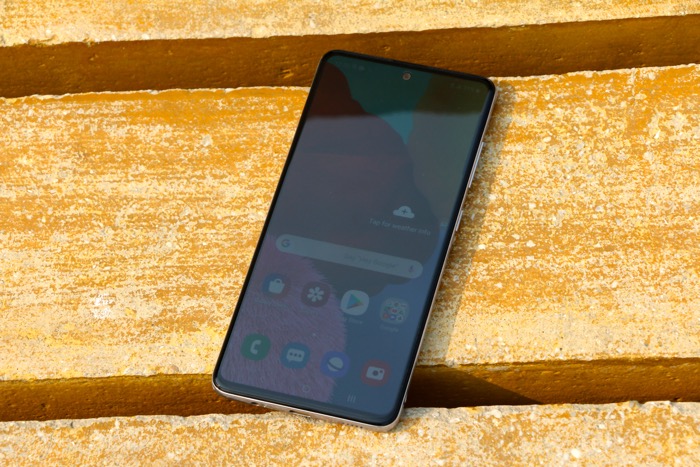
Samsung Galaxy A51 also gets an in-display fingerprint scanner that was also the part of A50. We wouldn’t like to give it the benefit of being a mid-range device for a little sloppy performance since we have already come across Vivo S1 Pro’s snappy unlocking. Samsung still struggles with its optical scanner; even the problem has been reported a few times with higher-end models. Samsung does not recommend to use a low-quality screen protector that might not perform accurately for reading the finger impression; the one that comes out of the box does not help either.
We consistently experienced a lag at the time of unlocking the phone, and it worsened, many a time, to an extent when it failed to scan the finger over and over forcing us to use an alternative method to unlock.
Performance and Battery
Samsung Galaxy A51 carries a mid-range chipset, Exynos 9611, and for the graphics, a Mali G72 GPU. They are further supported by 6GB RAM and 128GB internal storage expandable up to 512GB through a MicroSD card. Depending upon the region, you may also come across a 4GB or 8GB RAM version as well. The four bigger cores are clocked at 2.3Ghz for heavy works while the smaller cores are clocked at 1.7Ghz.
The chipset may not be a bigger improvement from the earlier 9610 inside A50, but surely, the One UI 2.0 on top of Android 10 is the real excitement for the Samsung fans.
On AnTuTu, it scored 186414 that is not far ahead of underperforming entry-level Galaxy A20s that reached 181215; however, A51 is still better in numbers than some of the rival Chinese phones such as Vivo S1 and S1 Pro, Realme 5 Pro and Honor 9X.
In real life performance, we found it almost similar to what the Galaxy A50 did during our tests. The processor can handle day to day tasks very easily though a little lag can be felt at the time of switching apps, which is fine for a mid-range device. At the end of the day, it all depends on how high you expect from a mid-level chipset.
We could play PUBG at higher graphics settings for longer sessions with intermittent minor frame drop that pushed us to bring down graphics. The game booster comes built-in, which helps to allocate more resources for the game apps, but that does not seem to efficiently work if other resource-hungry apps are running side by side, the lag becomes more prominent then.
Samsung Galaxy A51 packs a 4000 mAh battery and a 15W charger that is capable of fast charging. It can refill the battery from 0 to 100% in 1 hour and 53 mins, almost two hours. On the other side, it can easily get you through an entire day before you will need to recharge it again.
Our video play test drained the battery in 15 hours and 52 mins which brings it on par with Vivo Y19’s 5000 mAh battery. Both fall behind Samsung’s own A30s 16 hour and 13 mins.
Our four hours battery test on mobile data (4G) took away 66% of the battery juice. You can have a look at the following chart to see what battery performance you should expect from this phone on social media.
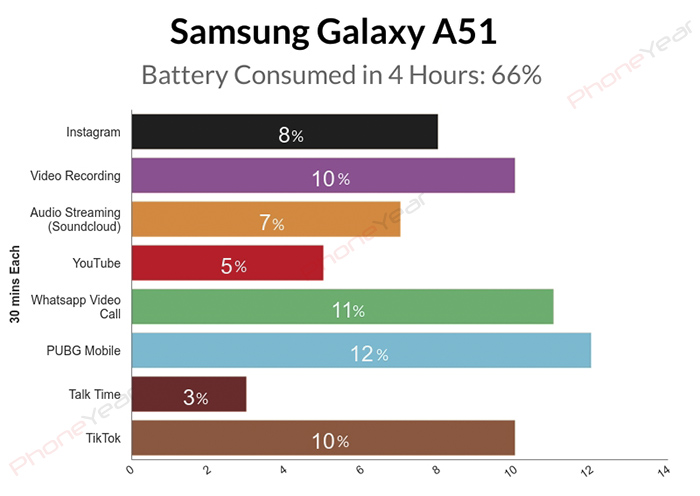
Samsung Galaxy A51 Camera
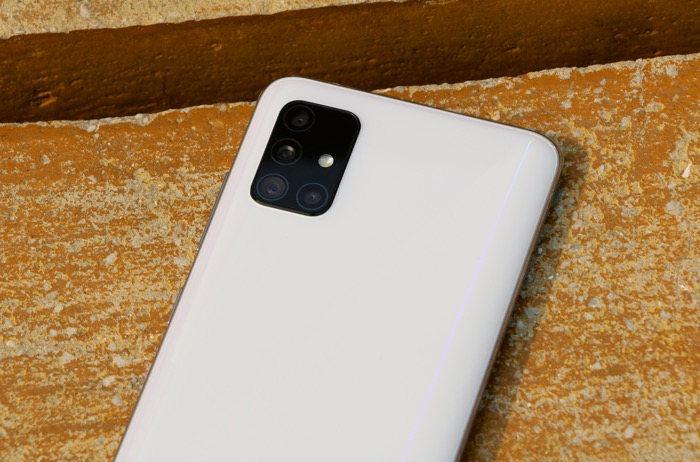
A primary difference Samsung Galaxy A51 creates this time is the quad lens setup in contrast to the triple camera in A50 that, too, was limited to 25MP primary lens.
Here on A51, the main lens has been upgraded to 48MP Quad-Bayer, which is a more common asset now on almost every mid-range phone on the market.
A 12MP ultra-wide angle lens replaces the 8MP of the earlier model. Then a 5MP dedicated macro lens is another major upgrade that is far bigger than 2MP usual macro sensors we find on most of the Chinese devices that barely do the job.
And the last one is another 5MP depth-sensing shooter for bokeh effects.
On the front side, there is a 32MP Quad-Bayer selfie shooter settled inside the punch hole, which is again bigger than 25MP of 2019’s A50. However, it does not offer an LED flash on the front.
Though there are not many changes in the default camera app, you can still tweak things to customize the environment.
As usual, the bottom bar holds the menu we typically find in almost every other phone today that is swipeable. There is an option to rearrange them as well, which is very handy for most of the folks.
The top bar of the app holds a ‘setting’ icon on the left and an ‘aspect ratio’ key on the right side (next to the timer), which also holds the button ‘3:4H’ for 48MP full lens. The default is set to 12MP at 3:4.
You also get to play with slow-mo and super slow-mo that are shot in HD resolution (720p) with 20fps and 30fps, respectively. A Pro mode is also available, which is not as pro as you would wish. Although ISO, white balance, and exposure offer a limited range of values, it can still be useful for some creativity.
Day Images
Unless you choose the full 48MP lens from the aspect ratio menu, Samsung A51 shoots at 12MP, which is the default behavior of the phone camera.
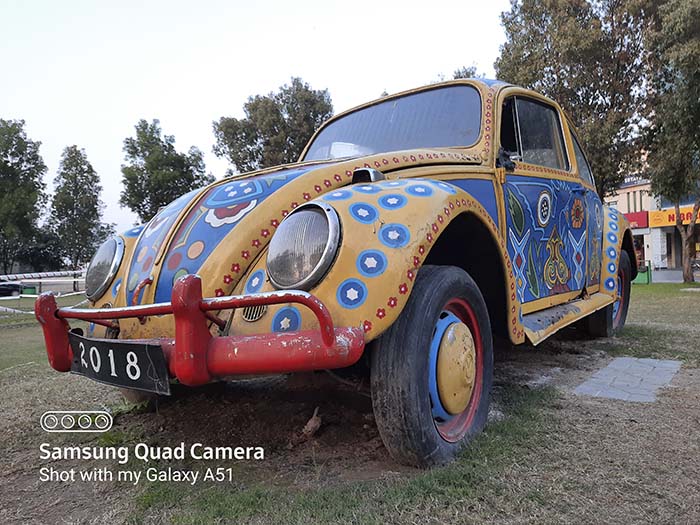
It decently captures the natural colors and does not turn them extra vivid, which we usually happen to experience in the Chinese rivals. Scene optimizer mode is available that recognizes the scenes in most of the cases and further boosts up the colors, which tend to show bluish effect in some of the cases.

Nevertheless, the noise level is well under control, and details are adequate if not the best at this price.
48MP is supposed to catch more details, but it only marginally improves the overall scene, though the file size increases considerably. You can also notice more noise in the picture. A51’s 48MP is not the best in town; we saw some better detail shots from much lower-priced Honor 9X in many situations. Check out the following images and the cropped version of the horse’s head that reveals A51 grabbed lesser detail though it appears to catch bolder colors.
Ultra wide-angle lens is a welcome addition, and although the color reproduction is comparatively better, the image details are far lesser than 12MP mode.
HDR is quite active on Galaxy A51 in both 12MP and ultrawide angle mode, but it is not available for a 48MP full lens. One needs to make a few taps for turning it on. Samsung might think to bring it out and stack it with the rest of the modes for easier access.
A51 can go up to 8x digital zoom that looks more like a cropped version of the 48MP lens, which gets a further software treatment for producing just acceptable images.
Night Images
Galaxy A51 has improved in the low light and night photography from the earlier A50; however, like other A series phones, it still badly struggles to handle artificial light sources and therefore behaves unpredictably against yellow and white light.
The Night mode is handy for dealing with light flare in many situations, but it can also behave unpredictably by massively increasing the noise level and adding to the scene unwanted yellow and green light out of the blue. Night photography and far off street lights appear to be an unresolved issue for Samsung phones that we even noticed to some extent in the flagship Galaxy S10 Plus last year. Have a look at the four minarets and dome of the mosque below showing green lights in the first image instead of the original yellow color. All three photos depict a different version of the same scene.
We could have defended Galaxy A51 for being a mid-range phone had we not witnessed much better night photography with Xiaomi’s Redmi Note 8 Pro, which is not only cheaper but a better performer too.
If you could ignore the light glare, Galaxy A51 is capable of taking some good shots where light does not interact with the lens directly. The night mode can even show a major improvement over the previous version.
Portraits, Selfies, and Macro
In the good outdoor light, it is capable of taking some very excellent selfies and portraits. The images are rich with facial detail; skin tone is natural, and overall color reproduction is quite balanced. With ‘Live Focus’, which is equivalent to portraits in Huawei phones, it can nicely blur the backgrounds.
For selfies, the full 32MP gets into action for the wide-angle mode, but for the standard shot, it unusually crops the image down to 20MP, which is also equally sharp and punchy. The same is not true for indoor selfies and portraits where noise level increases drastically, and images are less sharp even under good lighting conditions.
Samsung Galaxy A51 boasts a dedicated 5MP Macro lens that is bigger than rivals on the market. More megapixels also help to maintain a decent distance from the subject. Being a fixed lens, it needs extra stable hands that result in some really nice shots in the daylight. The backgrounds are nicely blurred, and subjects stand out bigger than usual. It works similarly at night, provided the light is adequate in the surrounding.
Videos
Samsung Galaxy A51 can shoot up to 4K videos from both of its cameras, front and back, at 30fps, but they only offer stabilization for 1080p videos. However, you can turn on the super steady mode for 1080 and 4K alike that make use of the ultrawide lens along with some software tweak. It downgrades the video quality at the cost of stability.
The Super Steady mode works reasonably during the day; however, the result at night is nowhere impressive when the entire scene becomes darker and nearly unacceptable.
Galaxy A51 can also shoot slow-mo videos for a longer length, whereas, super slow-mo is limited to a mere 8 seconds in which you get not more than four seconds of real action. At the right distance and under good light, the phone can record some fantastic HD videos that can easily run on any platform.
Verdict
Samsung Galaxy A51 is a decent addition in the A-series. Only if you are not bothered about unpredictable and shaky photography skills in the low, the macro shots and slow videos are definitely going to impress you. The Super AMOLED screen of this size is surely an attraction that coupled with an awesome rear design makes this phone a tempting device. If you are looking for a stable camera and performance is also on your chart, also look at Xiaomi’s Redmi Note 8 Pro or Vivo’s S1 Pro that are also good with battery life.
Alternative
If you are looking for better camera results and performance, you should consider Redmi Note 8 Pro, Vivo S1 Pro as well as Huawei Nova 7i, which are priced way less than Samsung Galaxy A51, to be your new everyday companion. If you are looking for superior battery performance as well, then you will not lose anything by choosing Vivo S1 Pro.

